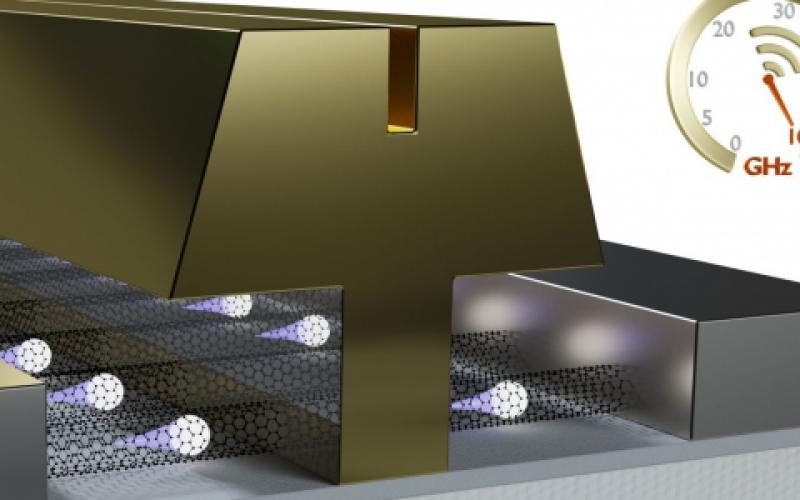The quantum technology may improve everything from 5G to tactical radios.

High-frequency radios may be more resilient, military sensors more sensitive and 5G communications more versatile because of a technological breakthrough initiated by the Army Research Laboratory. Carbon nanotubes, the exotic material that offers a broad scope of promises, now can be fabricated into transistors that would replace those of conventional metal oxide semiconductors used commonly in radio frequency systems. Ultimately, they would pave the way for less expensive chips that would eliminate many of the drawbacks that plague radio frequency systems.
The breakthrough was attained through research by Carbonics Inc., in partnership with the University of Southern California, and supported by funding from the Army Research Office (ARO), which is an element of the U.S. Army Combat Capabilities Development Command’s Army Research Laboratory (ARL). Scientists developed carbon nanotube technology that can achieve radio frequency (RF) speeds in excess of 100 gigahertz (GHz), which would permit better military and commercial communications systems.
Joe Qiu, program manager at the ARO, explains that carbon nanotubes have great potential for transistor applications. Their linear nature and high performance make them attractive for transistor technology. With their one-dimensional electron transport characteristics, they have been pursued by researchers for this application for many years. The ARL invested in its development some time ago through a single investigator project in ARO’s core program and followed research progress over the past 10 years. Meanwhile, experts in the field pursued ways to overcome challenges.
A few years ago, Qiu observed that breakthroughs were at hand and initiated a new project through the Army’s small business technology transfer (STTR) program. The biggest challenge has been scalability so carbon nanotubes can carry more current, Qiu says. The latest advances demonstrate that scalability can be met. “The investment of more than 10 years ago has started to pay off,” he allows.
Carbonics employed a deposition technology it calls ZEBRA to densely align and deposit carbon nanotubes onto a variety of chip substrates. These include silicon, silicon-on-insulator, quartz and flexible materials. As a result, the new technology can be integrated directly with traditional conventional metal oxide semiconductor (CMOS) digital logic circuits.
The development by Carbonics goes beyond validating its scalability, Qiu continues. It demonstrates how to make this type of integrated circuit operating at a millimeter wave frequency—30GHz or higher. This technology, tested at 100GHz, is capable of millimeter-wave performance, which ranges from 30GHz up to 300GHz.
Commercialization of the technology can be attained within five years with sufficient investment, perhaps even sooner, Qiu offers. The company already offers for sale its ZEBRA developmental wafers demonstrating prototype circuits.
Carbon nanotubes take different forms, Qiu explains, and only the semiconducting type are useful as transistors. Current integrated circuitry employing CMOS and gallium arsenide technology requires a huge investment in fabrication plants. Carbon nanotube circuitry can be made at much lower expense, Qiu says. “It’s possible to develop carbon nanotube technology with very low cost,” he adds. “You don’t need billions of dollars for a foundry.”
Size, weight, power and cost are major factors that affect mobile military communications, and lower costs can add up for the Army. Incorporating the technology into tactical communications and sensor systems would produce major savings based on the large numbers of deployed systems. And, because of their linear nature, they can perform can better.
The technology’s improved high-frequency performance can be a boon to 5G. That protocol originally was rolled out with a capability of under 6GHz, with many current standards planning for 28GHz, Qiu notes. Others are planned for 39GHz frequencies, with possibilities up to 60GHz. Engineers want to push 5G to higher frequencies, Qiu says, and these are well within the performance parameters of carbon nanotube circuitry. The generation beyond 5G will feature even higher frequencies. Qiu allows that the ARL is working on higher frequency communications well above 100GHz in internal and external programs.
Military sensing equipment also can benefit from the nanotube technology. For example, radar receivers can reap better performance from circuitry based on the technology. The linear nature of carbon nanotube technology will enable a high dynamic range, thus allowing a receiver to pick out a very small signal amid a high interference environment.
Tactical communications will experience the same benefit from this high dynamic range. Radios will have improved reception and a better chance of rejecting interference, even to the point of being relatively immune to jamming, Qiu offers.
This would be especially useful to high-frequency (HF) radios, which are enjoying a renaissance in tactical non-line-of-sight (LOS) communications. Even with satellite communications largely providing the bulk of non-LOS tactical communications, defense planners see the utility of having a backup system in the event that military satellite connectivity is knocked out. Qiu relates that the Army has an STTR in source selection to build jamming resistance into HF radios.
The time frame for this technology being incorporated into military depends in part on its commercial development. If it enters the commercial world in five years, the military will not be far beyond. Qiu estimates up to 10 years for its military deployment, adding, “It all depends on the level of investments. If there is no investment, then it will not go anywhere.” He adds that with more resources to continue its development, the potential for this technology’s military and commercial use could be far-reaching.